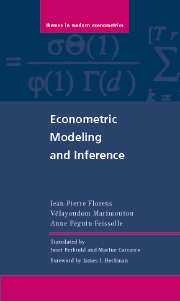16 - Identification and Overidentification in Structural Modeling
Summary
Introduction
In the previous chapters, we presented a set of statistical methods that were initially general and then specific to particular classes of statistical models. These methods and models have been chosen because they were suited to treat economic data but they belonged essentially to mathematical statistics. It is sufficient to look at some textbooks for the application of statistics in scientific areas other than economics (physics, biology, sociology, psychology and so on) to find an important part of the tools presented here, sometimes with a different relative importance or a different terminology, but fundamentally similar regarding the modes of thought and the results. The recent development in econometrics attests of the increasing diversity of the methods it uses. Formerly centered around a small number of models, econometrics has seized more and more statistical techniques; there are few statistical methods that have not found a use in the treatment of economic data.
Does the econometric method coincide with statistics? Most econometricians would answer no to this question. Most likely, the econometricians would consider that the autonomy of their field results from the approach of structural modeling. In broad outline, we mean by structural modeling a specification of the statistical model starting from theoretical relations that describe the phenomenon under study. These relations result from the “micro” or “macro” economic analysis and are essentially the mathematical expression of behavioral rules of agents or groups of agents involved in the examined phenomenon.
- Type
- Chapter
- Information
- Econometric Modeling and Inference , pp. 395 - 420Publisher: Cambridge University PressPrint publication year: 2007



